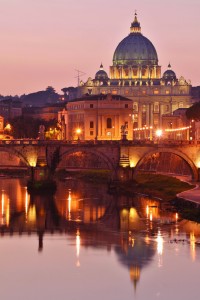This iconic view of St Peter’s Basilica and the Ponte Sant’Angelo that leads towards it is instantly recognizable as Rome, but 500 years ago this view began to change significantly…

There are several reports of Roman travellers of the 16th century returning home after some time abroad to find a city they said they barely recognised, such was the extent of municipal renovation at the time. Largely, these travellers were impressed by the new additions to a city that had, in the previous millennium or so, rather been left to the fates (though a few did lament the destruction of some familiar corner shop or run of houses in their home neighbourhood).
The Ponte Sant’Angelo would have been one landmark they did recall – the bridge has stood here since the days of Emperor Hadrian – but the Old St Peter’s Basilica, which had stood since the 4th century AD had, like much of the city, fallen into ruin, and was now (though not without controversy) in the process of being completely rebuilt.
St Peter’s Basilica has always been the preeminent symbol of Rome as the home of the Catholic Church. According to Roman Catholic doctrine, St Peter stands above all the other disciples in the hierarchy of Heaven, and indeed the Papacy itself goes back to him. However, according to the Protestants, whose radical new branch of Christianity was sweeping northern Europe in the 16th century, Peter was no more important than any of Jesus’ disciples – and Rome (and this is what really hurt) was no more important than any other city in Christendom.
Rome needed a huge overhaul if it were to continue to be recognized as the home of Christianity. And a new cathedral. A big one. A huge one. A glorious one. An ostentatiously expensive one.
This was achieved – though at some price: it is reckoned that the rebuild of St Peter’s cost one and a half million scudi, a sum equal to the entire Papal State’s revenue for one year. With income from tributes and collections having been in decline for a couple of centuries already, it was, inevitably, the poor who paid for the build through a brutally severe taxation system that left scars on the agricultural landscape of Lazio that remain to this day. But the church did get built. The final elements of construction continued into the 17th century, though the last stone of the Cupola was laid, rather fittingly, on Christmas Day, 1589.
